Doggy Limousine Service
Daniel Williams, Rapid Paws
 Daniel Williams quit his regular job and opened a pet transport business, like Zoo-ber. It went well, although he had one customer than demanded he talk to their dog only in "baby-talk."
Daniel Williams quit his regular job and opened a pet transport business, like Zoo-ber. It went well, although he had one customer than demanded he talk to their dog only in "baby-talk."
Daniel Williams, of Washington, D.C., was a co-owner and driver for Rapid Paws, a limousine service for pets. It was started by Daniel and his partner, Paul Ozner, as a way to help people transport their pets in the Washington, DC area. They knew they wanted to start a business, and since they both had dogs and loved pets, they wanted it to be pet related. They also knew there was a problem and a need for people who couldn't transport their pets to a groomer or even a vet appointment. This might be because they worked or they might not have had access to a vehicle. There was also a big military presence that needed this type of service.
Daniel states the weirdest request he received was when someone asked him if he talked baby talk to the animals. Daniel stated it wasn't weird to him, as he talked baby talk to his own dog all of the time, but he could tell the man felt uncomfortable asking him. But when the question was asked, Daniel said the two of them really hit it off. So did he baby talk to this man's dog - of course, all part of the job!
Fighting Fleas
Lucy Pet Foundation
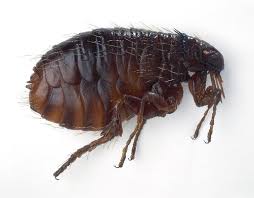 Chances are good your pets will get fleas, unless you live in Las Vegas or Phoenix. Is there a safer solution than the traditional topicals? Doc Halligan says there are lots of safe remedies for the 'battle of the fleas.'
Chances are good your pets will get fleas, unless you live in Las Vegas or Phoenix. Is there a safer solution than the traditional topicals? Doc Halligan says there are lots of safe remedies for the 'battle of the fleas.'
Doc Halligan claims that flea-related diseases comprise more than 50-percent of all skin cases in certain areas of the country. Fortunately, common household fleas are easily controlled with preventative measures, and today there are a lot of great products out there to help prevent, kill, and control fleas.
If you use a topical product on your pet, read the label and look at the active ingredients. Not all topicals are the same. Never use a topical product containing pyrethrin on cats, as it is toxic to them. However, you can use products containing fipronil, which is safe for cats and dogs. Because most topicals don't get into your pet's bloodstream, they can be safer then using oral medications. If you're not sure what product to use, ask your vet.
Does your pet have a bad reaction to fleabites? Doc Halligan states that this happens because some fleas have a certain protein in their saliva that when they bite your pet, they put it into your pet's skin. Some animals will then have an allergic reaction to this protein. This may cause some animals will break out over their entire bodies with sores from one bite, while other animals can be covered with fleas and not be bothered by them at all.
Because the length and severity of flea season varies across the country and changes from year to year depending on the temperature fluctuations and humidity, Doc Halligan recommends some form of flea control all year long. She states at the very least, you should start flea prevention in the spring to head off an infestation.
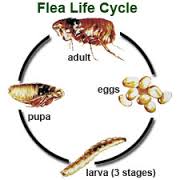 Learning more about fleas and their life cycle will help you understand why they become so prolific in such a short period of time and how to avoid an infestation. Although fleas thrive at 65 to 80 degrees F with humidity levels at approximately 80-percent, they have been known to survive indoors during the winter, even in cold climates. Fleas also travel - as much as one mile in an hour. They will hop inside through an open door or window and are often small enough to come through a window screen. Once inside your home, there's no place a flea can't go. Fleas can be miserable for you and your pet, and not just from the bites.
Learning more about fleas and their life cycle will help you understand why they become so prolific in such a short period of time and how to avoid an infestation. Although fleas thrive at 65 to 80 degrees F with humidity levels at approximately 80-percent, they have been known to survive indoors during the winter, even in cold climates. Fleas also travel - as much as one mile in an hour. They will hop inside through an open door or window and are often small enough to come through a window screen. Once inside your home, there's no place a flea can't go. Fleas can be miserable for you and your pet, and not just from the bites.
They can bring about a host of serious problems such as:
- Severe anemia: This condition is most commonly seen in very young or small pets with high numbers of fleas. Every year, kittens, puppies, and small dogs and cats suffer significant blood loss from fleabites that can actually lead to death from anemia. Signs include pale gums, weakness, and fatigue.
- Tapeworms: Cats and dogs develop tapeworms from ingesting a flea that is carrying the tapeworm larva.
- Flea Allergy Dermatitis: FAD is the most common allergic skin disease of dogs and cats. Animals that have flea allergy can develop a severe allergic reaction to a protein in the saliva of certain fleas that is left behind from fleabites. This condition causes severe itching, rash, and more. In dogs, it leads to hair loss and infection, usually on the rear legs or at the base of the tail; cats get scabs around the head, neck, and body. Medical treatment is needed.
- Plague: In rare cases, cats or dogs can get the bacteria that cause the plague from a rat flea or by ingesting a dead, infected animal. Symptoms include high fever, lethargy, and enlarged lymph nodes. Luckily, the disease is highly treatable if caught early.
Flea facts:
- Worldwide, there are more than 2,400 species of fleas.
- In the perfect environment, a flea can live for up to two years.
- The female cat flea consumes 15 times its own body weight in blood daily.
- A flea can jump 150 times its own length.
- Fleas have been around for 100 million years.
- Fleas can live without food for more than 100 days, but on average they live two to three months.
- Fleas can go through an entire life cycle, from egg to adult, in as little as 10 to 14 days.
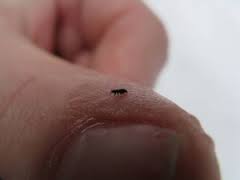 - Unlike the mosquito, which eats once and goes off to digest its meal, fleas continue to repeatedly bite their hosts long after their hunger is satisfied.
- Unlike the mosquito, which eats once and goes off to digest its meal, fleas continue to repeatedly bite their hosts long after their hunger is satisfied.
- The most common flea on dogs and cats is the cat flea, Ctenocephalides felis.
- Cat fleas have been found infesting more than 50 different hosts throughout the world.
- In North America, a wide variety of non-domesticated hosts have been reported harboring cat fleas, including coyotes, red and gray foxes, bobcats, skunks, rodents, raccoons, opossums, and ferrets.
- Once on the host, the cat flea will initiate feeding within seconds and mating will occur on the host in the first eight to 24 hours, with most females having mated by 34 hours.
- Female cat fleas begin egg production within 36 to 48 hours of taking their first blood meal, reach maximum production between four and nine days, and are capable of producing eggs for over 100 days.
- Female fleas can lay 2,000 eggs in their lifetime, but the average is 1,348 eggs during their first 50 days on the host, equivalent to producing their body weight in eggs daily.
- The life cycle of the fleas involves an egg, larva, pupa, and adult, just like a butterfly.
- The pupa stage is the most difficult to kill, as it's very resistant to most chemicals and can stay in this state for up to one year waiting for the proper conditions to hatch.
- Cat fleas lay their eggs while on the host, your dog or cat, not in cracks and crevices. Flea eggs are not sticky and readily fall from the host and into their environment.
- Once flea eggs are in the environment, they will usually hatch in one to 10 days, depending on the temperature and humidity.
- Cat fleas spend their entire lives on your pet. They feed, sleep, and lay eggs, thousands of them, all on the back of your pet.
- For the cat flea, no life cycle stage (egg, larva, pupa, or adult) can survive for 10 days at 37.4 degrees F, or five days at 33.8 degrees F.
It's important to realize that only 5-percent of the total flea population is in the form of adult fleas on your pet. The other 95-percent is in various stages: 50-percent eggs, 35-percent larvae and 10-percent pupae that are not readily visible to the naked eye but are in your carpet, furniture, bedding, lawn and anywhere else your pet walks or lies down.
During feeding, female cat fleas excrete large quantities of incompletely digested blood known as "flea dirt," which dries within minutes into reddish-black pellets that look like pepper. If you place some of this flea dirt on a white paper towel and apply water, it will turn the towel red.
 The key to controlling fleas is to interrupt their life cycle at an immature stage so they don't develop into adults. This means all pets in the household must be treated. When using preventative medication, always read all of the instructions prior to usage and never use on debilitated, very young, sick, or elderly animals without directions from your vet, and never use dog products on cats and vice versa.
The key to controlling fleas is to interrupt their life cycle at an immature stage so they don't develop into adults. This means all pets in the household must be treated. When using preventative medication, always read all of the instructions prior to usage and never use on debilitated, very young, sick, or elderly animals without directions from your vet, and never use dog products on cats and vice versa.
The Mission of The Lucy Pet Foundation is to reduce pet overpopulation by having mobile spay/neuter clinics across the country and to support causes that benefit animal welfare. The Lucy Pet Foundation not only offers free and reduced spays and neuters, they also do microchipping, vaccines and de-wormings. Spaying and neutering is not only great for pet population control, but it has been proven that an animal will live on an average of 40-percent longer after having this surgery.
Visit Website
How To Achieve Litter Box Success - Dr. Debbie
 It's important to realize not all cases of inappropriate elimination are a "behavior" problem. In confirmed behavioral driven house soiling cases, 20-percent of the cats also had a contributing medical condition at the time. So even if it sounds like a behavioral problem, see your veterinarian to ensure your cat isn't the 1 in 5 that has discomfort, infection, or other health problems influencing her litter box use.
It's important to realize not all cases of inappropriate elimination are a "behavior" problem. In confirmed behavioral driven house soiling cases, 20-percent of the cats also had a contributing medical condition at the time. So even if it sounds like a behavioral problem, see your veterinarian to ensure your cat isn't the 1 in 5 that has discomfort, infection, or other health problems influencing her litter box use.
Drawing Kitty To The "Right" Spot
Check the condition of the box - is it urine stained on the bottom? Throw it out and get a new one. Keep the box clean by scooping twice daily and by performing a complete litter change out twice a week for non-clumping litter or every 2-3 weeks for clumping varieties.
To entice kitty back to the litter box try a litter box attractant like the herbal-based cat litter additive called "Cat Attract."
Multi-cat homes or those with outdoor cats nearby should use pheromone (scent hormone) products to ease social stress and facilitate litter box harmony.
Kitty Eliminates Near, But Not Quite In The Litter Box
Your kitty is telling you that she understands what you want her to do, but something isn't quite right in the litter box environment. First start with providing a larger box, even if this means buying a plastic under bed storage box for this purpose. Look for one sized 18 x 36 inches in size.
Remove any litter box covers. Revisit the traffic flow in the litter box area. Ensure the box is in a quiet, low traffic area. Keep the box unquestionably clean.
Is Your Cat Urinating In Tubs Or Sinks?
Chances are your cat has urinary tract inflammation or infection. The cool surfaces provide relief to the inflammation or discomfort of a medical condition. See your veterinarian for a urine evaluation and treatment since environmental changes alone will not stop the behavior.
To preventing further episodes, decrease access to tubs and sinks, close doors to bathrooms, or fill the bottom of sinks and tubs with a small amount of water.
Kitty Eliminates On Throw Rugs And Won't Use Litter Box
Your cat has already made a litter preference. Perhaps the texture of carpet is more appealing than the litter used. Provide a litter box smorgasbord. This is when you provide multiple litter pans at the same time, each with different litter varieties such as clay, clumping, and natural pine litter. Be sure to include one litter box with sections of throw rugs or carpet remnants lining the bottom. During this time, remove all throw rugs from the house or block kitty's access to those areas.
If kitty demonstrates a litter preference, switch her litter boxes to that style of litter.
If kitty chooses the rug-lined box, then continue providing carpet lined litter boxes to establish a good pattern of repeated box use. Gradually start sprinkling small amounts of cat litter in the box on top of carpet surface. With time, many cats can be retrained to accept the box as the carpet is phased out and just litter remains.
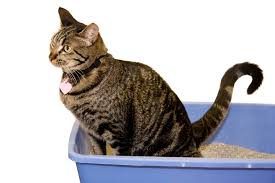 Prevent Returning To Scene Of Crime
Prevent Returning To Scene Of Crime
Clean all house soiling accident sites with an enzyme based pet cleanser. The enzymes break down the chemical component of the odors, and do more than just cover up with scents. Do not use ammonia based cleansers on accident areas - doing so is counterproductive. (Remember that urine contains ammonia products.)
Cats dislike eating in areas that they eliminate, so place food and water bowls in the site of the accidents, or try placing pieces of aluminum foil in areas to deter kitty's use.
Citrus scents are offensive to cats and can be an effective cat deterrent. Use citrus or potpourri scented air fresheners in the area. If your cat is eliminating in house plants, place lemon or orange peels in the pot to make the area less attractive. And of course, make sure you aren't using citrus scented cleaners on the litter pan!
To keep your kitty away from areas she continues to eliminate on, use double sided sticky tape or turn plastic carpet runners upside down. Another option is to invest in motion-activated devices that spritz out citronella or puffs of air when the electronic eye picks up motion in the off-limits area.
The Tough Reality
For some cats, environmental changes aren't enough and drug therapy may be a necessary tool. But remember that behavioral medications aren't a shortcut - drug therapy must be used with veterinary monitoring and in conjunction with environmental changes.
Want to hear some bad news? In households struggling with many years of feline house soiling, it may be necessary to discard urine marked furniture, change out carpet, carpet pads, and treat sub-flooring to effectively remove scent triggers for future elimination issues. It may sound extreme, but it can be important step to achieve faithful feline litter box success.
Featured veterinarian known as "Dr. Debbie" on national pet radio program, Animal Radio. Ebook author of "Yorkshire Terriers: How to Be Your Dog's Best Friend"; "Pugs: How to Be Your Dog's Best Friend"; "Mini Schnauzers: How to Be Your Dog's Best Friend"; and "Shih Tzu: How to Be Your Dog's Best Friend." Dr. Debbie's books.
Visit Website
5 Reasons You Should Adopt A Cat
Robert Semrow, Listomania
 June is adopt a cat month and the perfect time for you to consider adopting a cat and this year I'm certain more men are heading this way as well. Why? Well in recent years there's been an up-tick in men adopting cats. Regardless of your gender, cats can make a wonderful addition to your home and I'm going to share 5 reasons why you should welcome a cat in to your family.
June is adopt a cat month and the perfect time for you to consider adopting a cat and this year I'm certain more men are heading this way as well. Why? Well in recent years there's been an up-tick in men adopting cats. Regardless of your gender, cats can make a wonderful addition to your home and I'm going to share 5 reasons why you should welcome a cat in to your family.
To begin with, you are saving lives. Now I know that may seem obvious, but for many it's not. Yes, it's important to find a home for cats in need as they deserve a forever home where they can flourish. However, the saving lives part may also include you and your family members. Studies have shown that pets can lower blood pressure and be tremendous stress busters. Just a few minutes with a cat can make a word of difference in your physical and mental health.
Next is that they are non-stop entertainment, without the need for a computer or TV screen. Cats are incredibly entertaining creatures who don't need much to find joy in. From a simple box to paper to a ribbon or just looking out the window at the world, a cat's ability to entertain themselves is something that quickly becomes entertaining to all around them. Cats are also able to find joy in just viewing the world from a different angle. Enjoy watching all the different ways your cat finds to rest or relax in spaces and on ledges that simply defy gravity, if not common sense.
Next is that they are very intelligent and take less effort in many ways than dogs. They do not need a lot of paw holding or opening of doors to use the green room. In fact, most cats figure out the litter box routine quickly and easily. Additionally, they bathe themselves and don't have to be told twice to do so. This is great because it's healthier and safer, as putting a cat in water is not a fun chore for those who are not scratch resistant.
 Another reason is that they are easier to adapt in to your lifestyle. They are independent by nature and don't mind that you have to go to work for longs hours each day or might need to continue working for a while when you get home. They are very good at letting you know how much time and attention they need, then when their people time tanks are filled, they go back to their safe spaces to relax, observe and plot.
Another reason is that they are easier to adapt in to your lifestyle. They are independent by nature and don't mind that you have to go to work for longs hours each day or might need to continue working for a while when you get home. They are very good at letting you know how much time and attention they need, then when their people time tanks are filled, they go back to their safe spaces to relax, observe and plot.
Finally, and this is one that those who aren't cat people don't get. They are excellent snugglers and are affectionate. They are able to snuggle themselves in and keep you and themselves warm. They want to be around you and share close moments of tenderness while not crushing you. Yes, Almost all cats are lap cats; as opposed to those 100+ pound dogs who only think they are lap dogs.
If you're still not sure, turn on the your internet video channels and search for cats doing awesome things like playing keyboards, dressing up like stars, singing and so much more.
Share your reasons to adopt a cat on our Animal Radio Facebook Page.
Visit Website
The Dogfather's Grooming Tip with Joey Villani
 Aromatherapy Pet Shampoos
Aromatherapy Pet Shampoos
Do aromatherapy shampoos actually work on your pet or are they just a fad?
When aromatherapy is used in its purest form, like essential oils that are used in diffusers, it actually works very well. Joey can vouch for this, as he has tried it on one of his own pets that couldn't deal with thunderstorms.
Because there have been claims that aromatherapy works well on all types of pet behaviors, it's no wonder companies are now trying to duplicate this effect in the form of shampoos.
Joey has done tests with the top three products and unfortunately he doesn't see any difference. He has talked to some of the chemists who are actually making aromatherapy shampoos, and they state that if the product doesn't have the true form of essential oils, meaning 100-percent, it's not going to have the effect that you're looking for. Plus, with most shampoos, you are diluting them, which decreases the amount of oils even more.
The bottom line, according to Joey, is that if you like the way they smell and how they work on your pet's coat, then don't worry about the science behind them of trying to correct any problems with your pet's behavior.
Animal Radio News - Lori Brooks
 Millennial Pet Owners
Millennial Pet Owners
There's some interesting information about Millennials as pet owners. First, Millennials are the generation between the ages of 18 and 35 and apparently take their role as pet parents very, very seriously. In fact, Millennial pet owners demonstrated an overwhelming urge to pamper their pets, according to research in a report titled, "Millennials as Pet Market Consumers." Need a gift idea for a Millennial? Well, both dog and cat owners in the age group are much more likely than other pet owners to buy toys and fashion accessories for their pets and those pets are usually under 25 pounds because they want a pet that they can pick up and carry and take with them where ever they go. In short, compared to other pet owners, Millennials are more likely to be anxious about the health and safety of their pets. They also are more inclined to pamper, coddle and keep their pets with them whenever they can, while using technology to keep an eye on them when they are away from home. If this sounds like pets play the role of surrogate children for many Millennials, it's because they do. The vast majority (71-percent) agree that having a pet is a good way to get ready for having a family. Around 30-percent of Millennial dog or cat owners also prepare home-cooked meals for their pets, compared to less than 20-percent of us in the 35-and-over age group. They are also much more likely than other pet owners to use raw pet food and organic, natural or non-GMO foods for their furry family members.
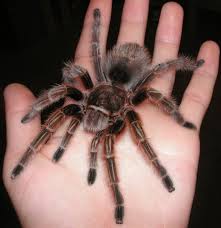 Eight-Legged Pets
Eight-Legged Pets
You may not think of big hairy spiders as pets, but some people do, and Petco wanted their business. The company expanded their 'tarantula offerings' to give pet parents the chance to further explore the amazing world of arachnids. The retailer said it was also proud to share that with the launch of more than 20 breeds, all of Petco's tarantulas will be captive-bred, adding that, "These unique and fascinating animals are a great addition to any home, offering endless learning opportunities for the whole family." Interestingly, not only do tarantulas have eight legs, they also have a large round eye surrounded by three smaller ones on each side for a total of eight eyes as well. They also shed their exoskeleton, or molt, in order to grow, doubling in size with each molt. And, did you know that female tarantulas can live up to 30 years while males have significantly shorter lifespans of up to seven years with proper care? Some of the breeds they carry include: Mexican Curly Hair, Rear Horned Baboon tarantula, Guyana Pink Toe, Mozambique Golden Baboon, Costa Rican Tiger Rump and the Ivory Ornamental tarantula!
The World of Pets Is Changing
Off-leash dog parks lead the pack in the type of urban parks being built, growing by 89-pervent since 2007, according to The Trust for Public Land's data on the nation's 100 biggest city park systems across the country. Nearly every big city now has at least one dedicated dog park, often with a name that reflects the creativity of the movement. Fort Worth pups play at Fort Woof; Memphis pets frolic at Overton Bark; Dallas dogs run at My Best Friend's Park; and Atlanta pooches have their own Freedom Barkway. When it comes to the number of dog parks, the cities that score the highest on a per-resident basis are Henderson, Nevada; Portland, Oregon; Norfolk, Virginia; Las Vegas, Nevada; and Madison Wisconsin.
 Don't Walk Your Dog By Hanging Leash Out of Car
Don't Walk Your Dog By Hanging Leash Out of Car
A California woman captured video of another woman driving her car and walking her dog by holding its leash out of the car window. The woman who took the video also confronted the woman in the car asking why she was walking the dog like that and the driver defended herself, saying the dog wasn't being dragged. But then the video shows the car speed up, forcing the dog to run along beside the car to avoid being dragged. The director of the local animal services department also said he found the video distressing and recommended the woman be charged with animal cruelty, but police reviewed the video and did not believe there was evidence of cruelty, but said the woman in the car would have been charged with 'distracted driving' IF she had been seen by an officer.
Social Media Creates Popular Pets
A Mars Petcare US', the world's largest pet care company, survey explored how pets have invaded pop culture, even becoming megastars in their own right, all thanks to the power of social media. They found that we are pretty pet obsessed. About 65-percent of pet owners post about their pets an average of two times per week. More than half of pet owners polled care more about getting 'likes' and/or comments for their pet-related posts than they do for those most other topics. And, 30-percent of us who have pets follow famous animals online. It's obvious; pets have really become a major part of our digital lives.
 Domestic Dispute Turned Out To Be Parrot
Domestic Dispute Turned Out To Be Parrot
Police in Brighton, Canada were called out to a home on what was a routine Tuesday night that turned out to be very unusual. It was 8 o'clock at night and neighbors heard what they believed to be a domestic dispute, since they knew a couple lived there. Police said neighbors told them they heard the man yelling and saying, "I hope you die," and other horrible things. But when police arrived, they could find only one person inside. It turned out that the man was home alone and had been screaming at his pet parrot that apparently was "beaking off" in his words. You might have guessed, the man had been drinking, but the parrot did not appear to be hurt. No charges were filed.
 Listen to the entire Podcast of this show (#1176)
Listen to the entire Podcast of this show (#1176)





